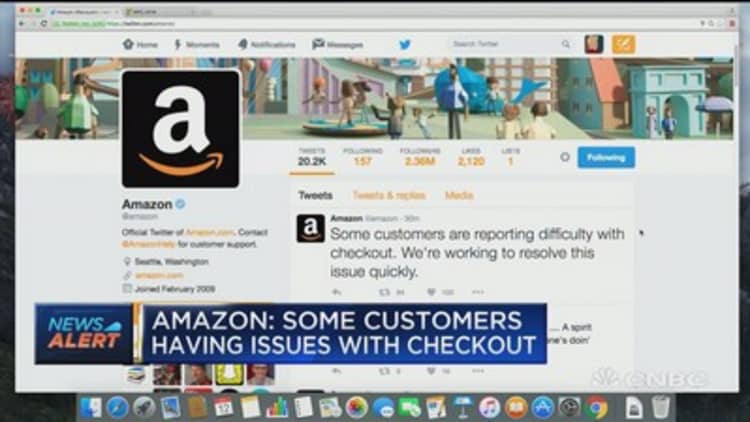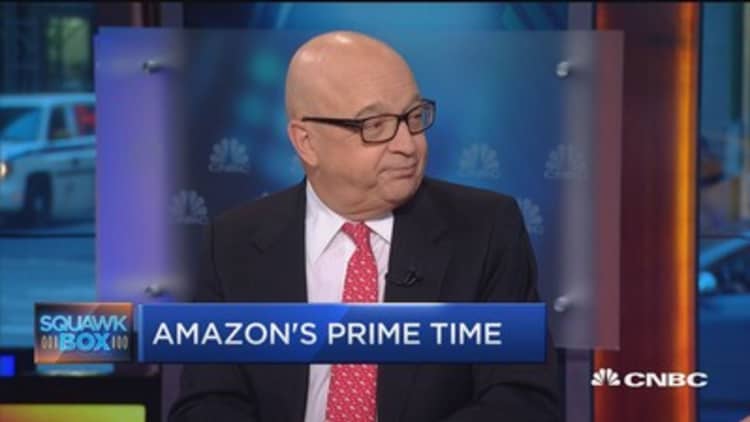



Let's give them something to talk about.
Following shoppers' complaints that Amazon's inaugural Prime Day felt more like a garage sale than a Black Friday doorbuster, the retailer's second take on the made-up sales event is embracing all things weird.
While Tuesday's sale offered steep discounts on popular items including a Samsung curved 55-inch 4K TV for $650, or nearly half off, and a KitchenAid Stand Mixer for about $250, or $100 off, it also included things like beard oil and light bulbs.
The retailer even had a page of deals called "Weird and Wonderful," where it touted such items as LED flashing finger gloves and adult-size animal costume pajamas.
"I think last year it was kind of unintentional. This year it's very intentional," Steve Osburn, a director at Kurt Salmon, said of the event's sometimes strange assortment. "At the end of the day it gets people talking so it's working."
Indeed, shoppers took to social media on Tuesday to share their strange findings:
By early afternoon, e-commerce software company ChannelAdvisor said that Prime Day's revenues were in line with the prior year. ChannelAdvisor helps roughly 3,000 retailers sell online including on marketplaces like Amazon. "It looks like Amazon has spread out the deals more," ChannelAdvisor's Scot Wingo said.
Amazon shares ended the day slightly lower, near $748, after recovering some of the ground they lost immediately following ChannelAdvisor's report. Piper Jaffray analyst Gene Munster said his firm remains confident that Prime Day will result in unit growth of 37 percent or more, as ChannelAdvisor's data does not cover all Amazon sellers. It also relates solely to comparable sales trends, Munster said.
"Given total suppliers have more than doubled for this year's Prime Day, it is naturally expected that same-store sales growth would be facing a headwind," Munster told investors.
Late afternoon, Amazon spokeswoman Ana Rigby said Prime members were shopping at "record levels." She noted that Amazon has seen a more than 30 percent increase in the number of items sold by small businesses and sellers on Prime Day from a year earlier.
In the 24 hours leading up to the event, there were nearly 19,000 tweets about Prime Day, according to online media monitoring platform Visibrain. That's nearly double from the same period last year, when there were more than 9,000, the firm said.
And as of 12 p.m. ET there had been more than 142,000 Tweets about the event, compared with some 74,000 last year, the firm said. The hashtag #PrimeDayFail, which took off during last year's event, gained traction again, but its use was only a fraction of what it was last year, Visibrain said.
Amazon had defended its sometimes strange offerings ahead of Prime Day, saying that unlike Black Friday, the sale is more about self-gifting and stocking up on household goods. Indeed, in the days leading up to Tuesday's sale, Amazon offered discounts on products ranging from protein powder to an HP Notebook.
"What could be weird to one person may be wonderful to someone else," Amazon spokeswoman Julie Law told CNBC last month. "We really stand behind the deals we had last year and the deals we have this year."
It makes sense that Amazon's sale would cover such a broad range of products, said Traci Gregorski, senior vice president of marketing at Market Track.
"By nature their assortment is so large and vast that ... some of those [strange] things are going to come up," she told CNBC Tuesday. Still, Gregorski said it appears this year's assortment is "more geared toward things that people were looking for this year and Black Friday." That includes a broader selection on wearables and electronics, she said.
"The discounts are fairly significant," Gregorski said.
Her firm, which studied nearly 2,000 products at 6 a.m. ET, found average discounts ranged between 20 percent and 30 percent. Some of the steepest price cuts were on tablets, tools and video games, according to Market Track's data.
Early analysis from BestBlackFriday.com found that many of the Prime Day deals beat or were equal to the most recent Black Friday and Prime Day events. Phil Dengler, co-founder of the deals website, said the Samsung TV deal was particularly good.
"Last year, the lowest price for a similar Samsung television was at P.C. Richard & Son Cyber Monday... for $998.91," he said.
However, not all the deals were as impressive. Dengler said he was "a bit disappointed that the lowest price for a 32-inch TV will be $99" because Amazon had a TV that size available for $75 last Prime Day. Meanwhile, the lowest price for a 40-inch TV will be $139.99, Dengler said. "Amazon had this size for $115 on Black Friday 2015."
Separate analysis by Clavis Insight found the average discount for Amazon's featured "Spotlight Deals" was 42 percent, which is in line with the depth of its usual daily deals. And Boomerang Commerce, which analyzed nearly 28,000 deals, found 44 percent of the discounts fell in the under $25 bucket. Half the promotions it studied were for 10 percent off.
Meanwhile, some shoppers laughed about a "discount" of 5 cents on a Nixon women's watch, while others found examples of duplicate items on the site that were selling for less than the Prime Day version.
The company also hit an unrelated speed bump Tuesday morning, when multiple Prime members reported trouble adding items to their digital shopping carts. The problem was resolved by late morning, but may have weighed on the company's early sales results, ChannelAdvisor said.
And following customer complaints that Amazon's best deals were selling out too quickly last year, the company seemed to be handling the influx better this time. One strategy it used was stocking nearly double the number of TV units as compared with Black Friday and Cyber Monday combined. As of 11 a.m. ET, U.S. shoppers had ordered more than 22,000 TVs, Amazon said.
Of 22 high-profile "Spotlight Deals," only two were sold out by early afternoon. That includes the 55-inch Samsung TV, which sold out after eight hours, Amazon said. However, other deals were listed as "missed" or "100 percent claimed." Gregorski said Amazon also did a better job making its deals easy to find this year, by allowing members to shop by category.
Despite criticism, Prime Day was a runaway hit for the company last year. During what is typically a slow month for retailers, the event — which marked Prime's 20th birthday — led to Amazon selling more units than it did on Black Friday 2014. At the time, that was its biggest Black Friday ever. (Cyber Monday, which is rooted in online shopping, tends to be a bigger day for Amazon.) It also led to more new members trying its Prime membership than on any day in its history, Amazon said.
Separate data from comScore found that Prime enrollments peaked on July 14, one day before Prime Day, as shoppers registered so they could participate. Signups were 14 times the year's daily average prior to the announcement of Prime Day, comScore said. According to the firm's data, 21.7 million unique visitors went to Amazon.com on Prime Day last year, just shy of the 22 million who visited on the prior Cyber Monday. Yet while 5.4 million people placed orders on Cyber Monday, only 4.4 million did so on Prime Day, comScore said.
Amazon did not set a specific sales goal for the event's second iteration, though Law said it should be "another record-breaking Prime Day." However, the benefits of Prime Day are expected to last beyond one day in July. Research released by Consumer Intelligence Research Partners on Monday estimates that 63 million people in the U.S. are Prime members — an increase of 43 percent from the weeks leading up to last Prime Day.
Deborah Weinswig, an analyst at FBIC, predicts Prime Day could generate $525 million in sales, up 26 percent from its $415 million estimate last year.
Enrolling more shoppers in its $99 annual Prime subscription service is essential for Amazon's revenue growth, as these shoppers spend significantly more than nonmembers. CIRP estimates that Prime members spend some $1,200 a year on Amazon, compared with $500 for people who don't pay for the service.
Once they sign up for Prime, they tend to stick around. Roughly 73 percent of shoppers who sign up for Amazon's 30-day trial convert into paid members, according to CIRP's data. And 91 percent of first-year enrollees renew for a second year.
Hoping to attract its own legion of loyal shoppers, Wal-Mart recently opened up its ShippingPass service, which like Prime offers free two-day shipping for an annual fee. A subscription costs $49 a year, but comes with a smaller assortment and fewer perks. Wal-Mart likewise dropped its free-shipping minimum for the week, and announced its own set of discounts.
This story will be updated throughout the day.


